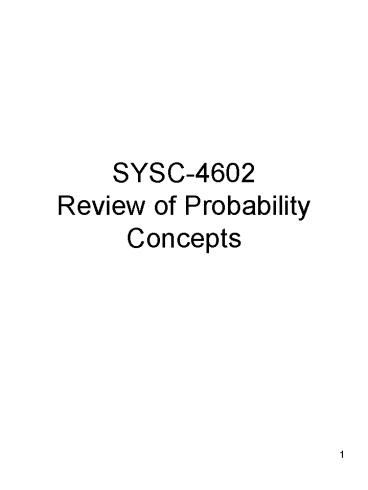SYSC4602 Review of Probability Concepts - PowerPoint PPT Presentation
1 / 18
Title:
SYSC4602 Review of Probability Concepts
Description:
Examples include Bernoulli trials, binomial distribution, Poisson distribution ... distribution, Exponential distribution, and Gaussian (Normal) distribution. ... – PowerPoint PPT presentation
Number of Views:35
Avg rating:3.0/5.0
Title: SYSC4602 Review of Probability Concepts
1
SYSC-4602Review of Probability Concepts
2
Review of Probability Concepts
- Probability Space
- Consists of a number of events Ai. Each event is
associated with a probability measure P(Ai)
S
A1
A2
3
Conditional Probability
S
A1
A2
4
Random Variables
- A random variable is a function that maps events
in a given probability space to the real line. - A random variable follows a mathematical law as
defined by the probability density function (pdf)
? fX(x) - Discrete r.v. has discrete pdf. Examples include
Bernoulli trials, binomial distribution, Poisson
distribution - Continuous r.v. has continuous pdf. Examples
include Uniform distribution, Exponential
distribution, and Gaussian (Normal) distribution.
5
Statistical Averages
Mean (Expected) Value of r.v. X
nth Moment of r.v. X
Central Moments of r.v. X
Variance
6
Examples
fX(x)
Uniform r.v.
x
b
a
Normal r.v.
7
Two Random Variables, X and Y
Joint Moments
Independence
Covariance
Correlation Coefficient
8
Random Processes
- Observing the sample functions at time tk we find
that the resulting collection of numbers
xj(tk), j1,2,,n forms a random variable. - Observing the sample functions at t1, t2, , tk
forms a vector of random variables X(t).
9
Stationarity
- A random process is said to be stationary in the
strict sense (strictly stationary) if the joint
probability function is invariant under shifts in
time
10
Mean, Correlation, and Covariance Functions
Mean of the process X(t)
Autocorrelation Function
Autocovariance Function
11
Wide-Sense Stationary
- A random process is said to be wide-sense
stationary (wss) when
- Power Spectral Density
12
Properties of Power Spectral Density of a Random
Process
- Mean Square Value
- Non-negativity
- Symmetry
- Filtered Random Process
Y(t)
H(f)
X(t)
13
Example
Y(t)
X(t)
H(f)
14
Gaussian Process
- A random process X(t) is said to be a Gaussian
process if the joint distribution of the random
variables X(t1), X(t2),,X(tk) is Gaussian
distributed
m is the kth dimensional vector of the means L is
the k x k covariance matrix
- If a Gaussian process is wide sense stationary
then it is also stationary in the strict sense - If a Gaussian process is applied to a stable
linear filter, then the random Y(t) produced at
the output of the filter is Gaussian
15
White Noise
- White noise is an idealized noise process with a
power spectral density that independent of
frequency
SN(f)
N0/2 d(t)
N0/2
f
16
Example
- Ideal Low-Pass Filtered White Noise
SN(f)
H(f)
N0/2
1
f
B
-B
17
Gaussian White Noise in BandPass Filter
SN(f)
N0/2
f
H(f)
1
fc
fc
f
t
SY(f)
N0/2
fc
fc
f
nI(t) and nQ(t) are two baseband Gaussian
processes
18
Thermal Noise
- Thermal Noise
- Due to the thermally induced motion of electrons
in conducting media. Power spectral density of
thermal noise is given by
h Plancks constant 6.63x10-34 k
Boltzmanns constant 1.38x10-23 T absolute
temperature 290 at 17c































